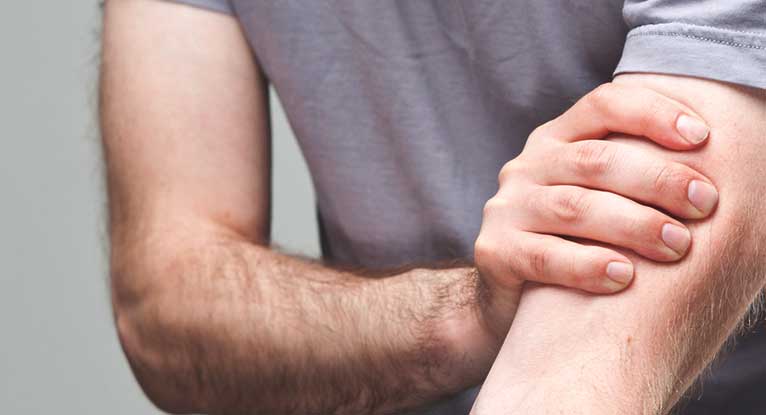
Heart Attack
Arm or shoulder pain can be a sign, especially if you also have pain or pressure in the center of your chest and shortness of breath. A heart attack can be sudden, but sometimes it’s gradual. The feeling might last a few minutes, or stop and return. Your stomach, jaw, back, or neck also might hurt. You could also get sick to your stomach, lightheaded, and clammy with sweat. Call 911 if you notice these symptoms.
Carpal Tunnel Syndrome
Nine tendons and a nerve (called the median nerve) pass through a tube called the carpal tunnel that goes from your forearm to your palm. Repeated movements, like texting, typing, or video gaming, can inflame the tube and push on the nerve. This could cause pain, especially in your forearm. You might also notice numbness, tingling, and a weaker grip.
Tendinitis
Making a motion over and over again, like when you turn a screwdriver, pull weeds, or swing a hammer, can create tiny tears in the tendons that join your muscles to the bones in your arms. Your arm might feel weak and hurt or burn, especially when you use it. Half of the people who play racquet sports (tennis, squash, racquetball) will get a form of tendinitis called tennis elbow at some point because of the constant swinging.
Sprain
A fall or a hit can tear a ligament, the tissue that connects the bones within a joint. This might happen at your wrist, elbow, or shoulder. It may be swollen, bruised, and hard to use. Treat it with RICE for the first 2 days:
- Rest: Lie down.
- Ice: Use cold packs 20 minutes at a time.
- Compression: Wrap a bandage around the area for support.
- Elevation: Raise the hurt area (above your nose if possible).
Give it a couple of months to fully heal, but see a doctor if you have extreme pain or swelling or your joint has a weird shape.
Strain
You might fall and pull or tear muscles or tendons in your arm. It typically happens when you overextend a joint, like your elbow, wrist, or shoulder. Treat it with RICE For the first 48 hours. Special exercises (physical therapy) can help if it’s still painful after a couple of weeks. Take it easy for about 2 months to give the injury a chance to heal.
Dislocation
A sudden hit or fall can separate two bones at the joint, often around your wrist or shoulder. The shape of the area might look strange and become swollen, numb, and painful. Sometimes it damages tendons, ligaments, or nerves. Your doctor may push the bones to put them back in place. After that, rest, ice, and physical therapy will help you heal. You may need surgery in rare cases. Medication can ease pain and swelling.
Stress Fractures
Though it’s much more common in your legs, repeated motions like hitting or throwing a tennis ball or baseball can make tiny cracks in the bones of your arms. Pain is often worse when you do the activity that caused it. Rest for 6-8 weeks to give it a chance to heal. If you don’t, you might create more serious damage that’s harder to treat.
Broken Bone
When a bone cracks or breaks completely in two, you could have serious pain, swelling, and bruising. Older patients might fracture an arm falling from a standing height. Falls and collisions in sports and car accidents are more likely causes when you’re younger. Your doctor will try to get your bone straight again and then keep it still with a cast so it can heal. Some bad breaks may require surgery and screws or pins to set the bone.
Bursitis
Small fluid-filled sacs called bursa cushion your joints and smooth the friction between muscle and bone. You can irritate them, often if you make the same motion over and over, like lifting boxes or throwing a baseball. Once inflamed, the pain is enough to interfere with simple things like dressing or combing your hair. The shoulder is the most common spot, but it might happen in your elbow, wrist, or anywhere else bones meet.
Impingement
The rotator cuff muscle sits between two bones: the shoulder blade and the upper arm. Injury or overuse, especially in sports, can inflame it. Then, when you lift your arm, the shoulder blade pushes or impinges, on the muscles, tendons, and bursa around it. This often causes pain and tenderness, especially in the front of your shoulder. Rest and icing are important. Anti-inflammatory meds and physical therapy can help, too.
Herniated Disk
Jelly-filled cushions, or disks, separate the small bones (the vertebrae) of your spine. A disk herniates when jelly leaks out through a tear. This substance can push on nerves and causes pain, numbness, or weakness. It’s typically a neck disk if you feel it in your shoulder or arm. Pain may shoot into your arm or leg when you sneeze, cough, or move a certain way.
Osteoarthritis
The cartilage that covers and protects the ends of your joints can break down over time. That causes pain and swelling and could make the joint hard to move. Wear and tear can cause it slowly, starting in middle age and getting worse, but injury could also do it. Splints, anti-inflammatory drugs, and simple exercises can help relieve pain and swelling. Try to take care of painful joints, but stay active to keep them moving.
Precision Pain Care and Rehabilitation has two convenient locations in Richmond Hill – Queens and New Hyde Park – Long Island. Call the Richmond Hill office at (718) 215-1888, or (516) 419-4480 for Long Island office, to arrange an appointment with our Interventional Pain Management Specialist, Dr. Jeffrey Chacko.













